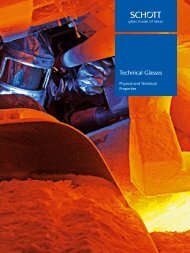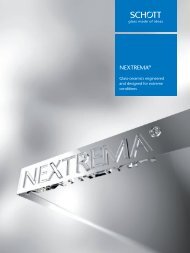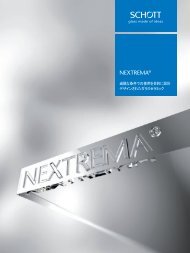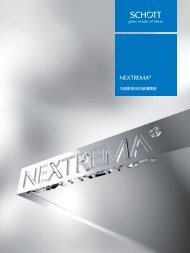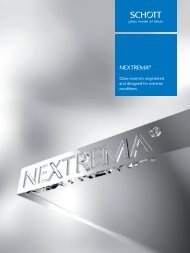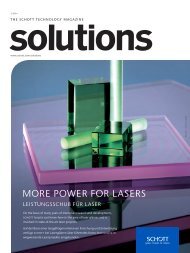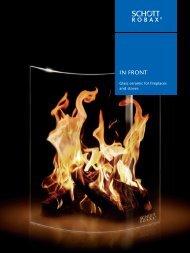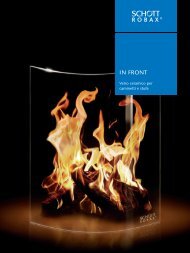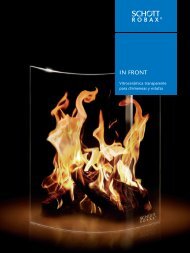Technology Magazine "SCHOTT solutions" - Edition 2/2013 - Technologie Magazin "SCHOTT solutions"
A variety of SCHOTT innovations The latest issue of our technology magazine “solutions” discusses innovations our SCHOTT experts are developing, how they provide support for our customers as partners and how they are addressing tomorrow’s challenges today. Our broad range of products and materials opens up a wide variety of different topics ranging from the universe all the way to the nano cosmos. We wish you enjoyable reading! Spannende Stories über SCHOTT Innovationen Die neuste Ausgabe des Technologiemagazins „solutions“ verrät, was SCHOTT Experten entwickeln, wie sie Anwendern kompetenter Partner sind und die Herausforderungen von morgen schon heute anpacken. Unsere breite Produkt- und Materialpalette erschließt dabei ein weites Feld: vom Weltall bis in den Nanokosmos. Viel Spaß beim Lesen!
A variety of SCHOTT innovations
The latest issue of our technology magazine “solutions” discusses innovations our SCHOTT experts are developing, how they provide support for our customers as partners and how they are addressing tomorrow’s challenges today. Our broad range of products and materials opens up a wide variety of different topics ranging from the universe all the way to the nano cosmos. We wish you enjoyable reading!
Spannende Stories über SCHOTT Innovationen
Die neuste Ausgabe des Technologiemagazins „solutions“ verrät, was SCHOTT Experten entwickeln, wie sie Anwendern kompetenter Partner sind und die Herausforderungen von morgen schon heute anpacken. Unsere breite Produkt- und Materialpalette erschließt dabei ein weites Feld: vom Weltall bis in den Nanokosmos. Viel Spaß beim Lesen!
Create successful ePaper yourself
Turn your PDF publications into a flip-book with our unique Google optimized e-Paper software.
<strong>SCHOTT</strong> SOLUTIONS 2/13 PHARMACEUTICAL PACKAGING PHARMAVERPACKUNGEN<br />
during testing in order to be able to comment on delamination. For<br />
this reason, it was impossible to control the production process in<br />
a timely manner,” Hladik adds. “In the <strong>SCHOTT</strong> Delamination<br />
Quicktest, a certain number of vials are removed from every batch.<br />
The random samples are then subjected to stress for four hours<br />
inside an autoclave to identify the delamination critical zone.<br />
In a second step, the vials are filled with high purity water (WFI –<br />
Water for Injection) and sodium is extracted inside an autoclave.<br />
The volume of sodium extracted correlates with the probability<br />
that the vials will experience delamination at a later point in time.”<br />
By monitoring these values and adhering to certain threshold<br />
values, <strong>SCHOTT</strong> is now able to control the risk of delamination<br />
for the first time ever. <strong>SCHOTT</strong>® Vials DC will be available in the<br />
ISO formats 2R to 10R (2 to 10 milliliters) starting at the beginning<br />
of 2014. <<br />
christina.rettig@schott.com<br />
Zweck hat das Unternehmen einen Schnelltest entwickelt<br />
und patentieren lassen. „Bisher musste man im Verlauf des Tests<br />
die Fläschchen aufwendig mit einem Stereomikroskop untersuchen,<br />
um eine Aussage treffen zu können. Auf diese Weise war es<br />
nicht möglich, den Produktionsprozess zeitnah zu steuern“, so<br />
Hladik. Die Funktionsweise des <strong>SCHOTT</strong> Delamination Quicktests<br />
beschreibt er so: „Aus jeder Charge wird eine bestimmte<br />
Anzahl Fläschchen entnommen. Die Stichproben werden im<br />
Autoklav vier Stunden lang in einer Wasserdampfumgebung<br />
unter Stress gesetzt und so die delaminationskritische Zone<br />
herausgearbeitet. In einem zweiten Schritt werden die Fläschchen<br />
dann mit hochreinem Wasser (WFI – Water for Injection)<br />
gefüllt und, ebenfalls im Autoklav, Natrium extrahiert. Der<br />
extrahierte Natriumgehalt korreliert mit der Wahrscheinlichkeit,<br />
dass das Fläschchen später delaminiert.“ Indem <strong>SCHOTT</strong> diese<br />
Werte überwacht und bestimmte Grenzen einhält, ist es erstmals<br />
möglich, das Delaminationsrisiko zu kontrollieren. <strong>SCHOTT</strong>®<br />
Vials DC sind im ISO-Format 2R bis 10R (2 bis 10 Milliliter) ab<br />
Anfang 2014 verfügbar. <<br />
christina.rettig@schott.com<br />
Photo Foto : <strong>SCHOTT</strong>/ T. Hauser<br />
<strong>SCHOTT</strong> developed a Quicktest for use in vial manufacturing to determine the<br />
risk of delamination with the help of threshold values. First, random samples<br />
are subjected to stress in the form of steam inside an autoclave to identify the<br />
zone in which the risk of delamination is the highest. Then, the vials are filled<br />
with high purity water and sodium is extracted inside an autoclave (see photo).<br />
The sodium extracted correlates with the probability that the vials will experience<br />
delamination at a later point in time.<br />
Um das Delaminationsrisiko anhand von Grenzwerten zu bestimmen, entwickelte<br />
<strong>SCHOTT</strong> einen Schnelltest für die Vial-Produktion. Zunächst werden<br />
Stichproben im Autoklav (siehe Foto) mit Wasserdampf unter Stress gesetzt<br />
und so die delaminationskritische Zone herausgearbeitet. Anschließend wird<br />
hochreines Wasser eingefüllt und im Autoklav Natrium extrahiert. Der extrahierte<br />
Natriumgehalt korreliert mit der Wahrscheinlichkeit, dass Fläschchen<br />
später delaminieren.<br />
18






